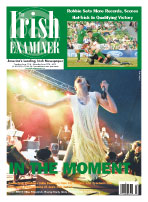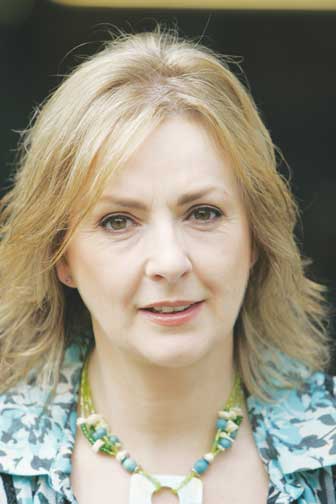


SERVICES
Tuesday March 9, 2010
Moya Brennan - The First Lady Of Irish Music
Moya Brennan By Gwen Orel When you're the First Lady of Irish Music, it's easy to get fellow musicians to open up and talk to you. So says Moya Brennan, the gentle-voiced, expressive singer and harpist who fronted Clannad (as Máire Ní Bhraonáin) and has gone on to a solo career. That "first" means "earliest" as much as anything else, she explained with a laugh during our interview in New York in late February. "I've been around for ages." Clannad, the family group made up of members of her family (her two brothers, her twin uncles, and at times, her little sister Eithne, later famous as Enya) formed in 1970, making it one of the earliest modern traditional Irish bands, and recorded their first album in 1973. "Clannad in Concert" was one of the first Irish traditional albums I ever heard (in vinyl, with a beautiful lyric sheet in Irish as well), and its jazzy, pure simplicity are still exhilerating-but I also love the fully-produced, more pop elements in the single "Theme from Harry's Game" (theme to a television show, and included in the album "Magical Ring", 1982) and the folk-rock, floaty sounds of "Legend" (soundtrack to the television series "Robin of Sherwood"). Brennan received a Grammy Award with Clannad for "Landmarks" in 1999. Moya is going strong: a new album is due this summer, and she plays New York's City Winery April 6 (check out full dates at moyabrennan.com), and was a natural choice to host the PBS Documentary "Music of Ireland: Welcome Home". But Moya did far more than host: she actively pursued interview subjects and conducted the interviews herself, many of them, she said, in various kitchens. "I hated the thought of going in to 'interview' people I've known for thirty years. I wanted there to be no paper in front of me. If we were to get soundbytes of people saying things, it would happen more in a conversation, sitting with somebody." And what people - over the course of the one-hour documentary (the one airing now is Part One; Part Two is expected to air over the summer) Moya talks to such luminaries as Planxty's Donal Lunny, Sinéad O'Connor, Film director Jim Sheridan, Riverdance composer Bill Whelan and dancer Michael Flatley, Pete Seeger, Black 47's Larry Kirwan, U2's Bono, Live Aid/Band Aid Founder Bob Geldof, The Chieftains' Paddy Moloney, and, in his last recorded interview, Liam Clancy. The documentary is dedicated to him. In addition, there is vintage footage of Van Morrison, the Clancy Brothers, the Dubliners and many more. "After sitting and talking, I would come out glowing. I was learning a lot, but also renewing friendships," Moya said. Rather than exploring why Irish music is popular, the film "tries to follow the path Irish music has taken, and to touch on the different genres of music that are there." It includes Irish pop music as well as traditional music (and part two, due this summer, plans to look even further, as well as at soundtracks to films). It explores the history of contemporary Irish music, of about fifty years. Of course, said Moya, there was music earlier than that, but "it kind of started with the Clancy brothers as the first wave of popular Irish music... them going on the Ed Sullivan show and not realizing what was going to happen to their lives afterwards." The documentary weaves commentary around such headings as "Planet Ireland," which looks at Ireland's isolation and poverty; "The Promised Land," investigating the influence of Greenwich Village on Irish music; and "The Pioneers of Rock," which looks at Thin Lizzy and the Pogues. Moya tells some of her own story too - there is footage of the fortieth anniversary of her father's pub, Leo's Tavern, in Donegal. It was there where she first got up to sing. "My father had a show-band years ago. When the show-band scene collapsed, social life moved into the pubs, because there was no alcohol in the dance halls. So my father bought a pub, and all he wanted to do was make it into a music place. He never drank or smoke in his life! When we used to come home from our school it was a stage for us. We'd sing anything from a Gaelic song to Joni Mitchell to the Beatles, and just discovered more and more of the beautiful Gaelic songs that our grandparents taught us." Gaelic was her first language and, she admitted, she still can't count in English above ten without doing it in Irish first. She described Donegal as "a remote, beautiful area to grow up in. It's the light there... if someone asked me what's that ethereal sound that Clannad has, it comes from Donegal." She and her eight siblings first heard pop music via Radio Caroline, the pirate radio station (there is wonderful footage of it, too). While they fell in love with the harmonies of the Mamas and the Papas and the Beach Boys, they also began collecting songs from the older generation, bringing "a half pack of Guinness, with the grandfather clock in the background." The old people "would tell you the story as much as they could, of the origin of the song, and then they'd give you the words, and the last thing they'd give you was the melody. And then, they'd tell you, go off and sing it your own way." So, it's important, she stressed, "when people talk about the precious treasures of the cultural music, not to be afraid to take it to another place." That spirit of renovation is one of the themes in the documentary that is closest to Moya's heart. "If you set the tree right, you can sprout as many branches from it as you want," she declared. By the time Clannad began writing their own songs, their roots in traditional music were deep - they didn't "go far off the branches." In the documentary "I wanted to show the root of Irish music." So she took her American crew to see a Fleadh Ceol - "just to see the kids. This is where it starts, with a little girl playing a concertina under a tree, 9 years of age." It's an opportunity she didn't have herself - there weren't comhaltas schools when she was a child. "Before the 70s, Irish music was still regarded as poor man's music." One of the highlights of the film is vintage footage of composer Seán Ó Riada, who is credited with much of the renaissance of Irish music in the sixties, with his band Ceoltóirí Chualann, and a section tracing the origin and impact of the Chieftains, many of whom first played in that band. Now, it couldn't be more different, she explained, smiling broadly. The thousands of children who participate in the Fleadh may not become professional, but the music is part of their education - regarded as necessary, the way sport is in America. Her teenage son and daughter play fiddle, uillean pipes, whistle, and piano between them. "What I tried to do was bring where Irish music has come from but also show how the different branches have sprouted." |
CURRENT ISSUE

RECENT ISSUES


SYNDICATE
[What is this?]
POWERED BY

HOSTED BY

Terms of Service | Privacy Policy
Website Design By C3I






